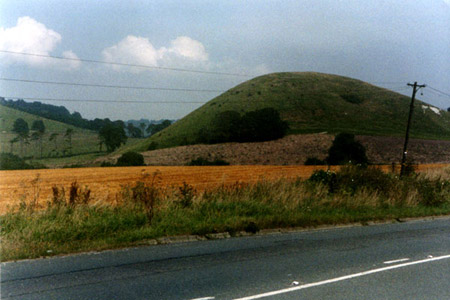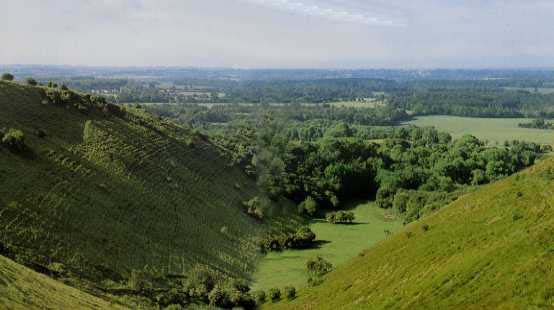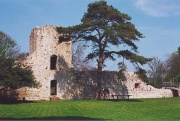Places
Eli Bishop (talk | contribs) |
Eli Bishop (talk | contribs) |
||
| Line 112: | Line 112: | ||
== The Warnings == | == The Warnings == | ||
{{:The Warnings}} | {{:The Warnings}} | ||
| − | |||
| − | |||
| − | |||
== Widders Bel == | == Widders Bel == | ||
Latest revision as of 00:21, 29 July 2013
Real locations mentioned in Riddley Walker.
Riddley's country, as shown in the original map drawn by Hoban, is a little less than half of what is now the county Kent, with its coast altered by flooding. The area is about forty by forty miles. You can see it superimposed on a modern map of England here, and enlarged details appear in the annotations courtesy of BJB.
The modern name appears in boldface after the name used in the book. Page numbers in parentheses indicate where they are mentioned in the book; the ones with no page numbers appear only on the map.
A20

The A20 connects Folkestone and Ashford. The "A" roads are national routes or what would be called state roads in the U.S., though the A20 is not one of the larger ones, having just two lanes. The route from Ashford to Folkestone is far from a straight line, as you can see on Riddley's map: the A20 meanders over hills and around farms—crossing and recrossing the straight 6-lane express monster of the M20.
One might ask why Riddley did not take the M20; there's no sign of the M roads on the map, and Riddley doesn't mention encountering any ruined overpasses. Either the M20 was built after 1980, or Hoban wished it out of existence for understandable aesthetic reasons. EB

(Probably a bit of both. The CBRD Motorway Database gives a timeline: the Ashford-Folkestone section was opened in 1981, but it would have been visibly under construction in 1980. RG)
(94)
Bad Mercy
Badlesmere, a small town south of Faversham. It was named for a line of Kentish noblemen, the first of whom, Baron Bartholomew Badlesmere, was hanged for treason at Canterbury in 1322 after opposing King Edward II in the Earl of Lancaster's rebellion. "Mere" is the Old English word for a body of water; the name means "Badle's/Baeddel's pool". In Riddley Walker, the town is later renamed Weaping.
(131, 207)
Bernt Arse
Ashford. "Bernt" is a double pun, as the town has been burned to cinders but already had "ash" in its name.
(1, 5, 15, 74, 120)
Bollock Stoans
Bullockstone. TH Note for American readers, "bollocks" = "balls"—a double pun, because "stones" are also testicles (Deuteronomy 23:1) RG.
(142)
Brabbas Horn
Brabourne. TH
Bundel Downs
Crundale. The Crundale Downs, part of the area surrounding Wye, are a chalk grassland—a hilly area of dense and diverse herbs on thin soil, with a vein of chalk underneath which runs all the way to the cliffs on the English Channel by Dover. They are currently the site of a national nature preserve. The name Crundale comes from the Old English for "chalk valley", and a down is a hill. "Bundel Downs" could also be a pun on "bundle up", i.e. against harsh weather.
(1, 15, 184, 186)
Cambry
Canterbury, the setting of Chapter 15 and part of Chapter 17.
(5, 15, 80-81, 88, 105, 106, 110-112, 148-150, 157, 159-161, 184)
Crippel the Farn
Capel-le-Ferne, just west of Folkestone. TH The name originally meant a chapel with ferns nearby. What is it that the new name invites us to cripple? The spelling of bombs as barms in the Eusa Story suggests that farn could be faun—maybe a relation to Eusa's stag.
(56, 60)
Dog Et
Dargate. The new name means "eaten by dogs".
(56)
Do It Over
Dover.
(5, 102, 120, 140-141)
Dunk Your Arse
Dungeness, the site of Kent's two nuclear reactors.
Fathers Ham
Faversham has a long industrial history reflected in its name, which comes from the Old English for "blacksmith's village". It was a major center of gunpowder manufacture in the 18th century RH which has led to more than one unfortunate incident EB.
There was a Roman staging post on the Watling Street, and it was a site of major Jutish settlement in the early fifth century CE; a Benedictine abbey was founded there in King Stephen's time. SF
Fork Stoan
Modern Folkestone is a small hilly seaside town, slightly larger than Dover. It is now known for the Channel Tunnel terminal—a long scar of bewildering machinery to the north of the town—but no such thing existed when the novel was written. There is an industrial area to the northeast where one might find the building full of shining machines mentioned in Chapter 12.
(5, 14, 56, 90, 96, 106, 109, 120, 170-171)
Frogs Legs
Possibly Frogholt, a hamlet northwest of Folkestone, though if so it is misplaced on the map. BJB
Good Mercy
Godmersham. TH Though Riddley's name for it mirrors Bad Mercy, the real derivation of the name is "Godmaer's village" (ham is a common suffix for towns).
(141-142, 150, 186)
Good Shoar
Besides appearing in "Fools Circel 9wys", Good Shoar plays no role in the story, but Hoban explained it in his afterword: "Good Shoar is Deal, where I paid a boatman to take me out to the Goodwin Sands." EE He later elaborated via email: "It is that part of the shore facing the sands where the town of Deal now stands. At one time in the dim and unrecorded past of Riddley's people there were rites there and possibly human sacrifice although I didn't develop this in the final version. The name Good Shoar is propitiatory, like calling the Erinyes the Eumenides. The Goodwin Sands rise and sink regularly and (I seem to remember reading) have sometimes brought up things long-hidden." RH
Hagmans Il
Hinxhill.
(90, 93)
Harts Ease
The Isle of Harty. TH
Riddley Walker has at times been compared to Beowulf. A couple of years ago someone came up with the (admittedly tenuous) theory that the action of Beowulf in fact took place not in Scandinavia but in the vicinity of Harty Island. MJ This was a conjecture by the archeologist Paul Wilkinson, who discovered buried boats on Harty that he believed to be of Germanic origin. In the 11th century, Harty was called Heorot, also the name of King Hrothgar's hall in Beowulf. Wilkinson proposed (British Archeology, 39, November 1998) that Beowulf actually described an early Germanic settlement in North Kent. EB
Horny Boy
Herne Bay, named after the village of Herne, which in turn is named after the mythological figure of Herne the Hunter. Herne is not a particularly well-known figure in British mythology, but he would have been familiar to British TV viewers in the early 1980s from his regular appearances in the series "Robin of Sherwood". He used to turn up in Robin Hood's visions with a pair of stag's antlers on his head—a "horny boy" indeed. MJ For other hunters and stags related to Riddley Walker, see Eustace.
(5, 120, 142)
How
Wye TH is currently a small college town between Ashford and Canterbury on the River Stour. It's surrounded by hilly terrain—the North Downs across the river, and Crundale and the Wye Downs to the east and south—with flatter farmland to the southwest toward Ashford. On Riddley's map, How Fents seems to be a little further southeast away from the river—but this is not surprising since these are semi-nomadic people who live in movable settlements, rather than in the ruins of the old cities.
The pun between Wye and How is not arbitrary: "How" suggests the search for knowledge, and people on the edge of survival are more concerned with "how" than "why."
(14, 15, 26, 29, 60, 147, 186)
Inland
England (or what's left of it). See also Outland.
Though Riddley's map only shows a small area, the general geography is consistent with a rise in sea level that ought to leave a good deal of the rest of Britain intact, and Riddley writes on the map that he doesn't have room for the whole of Inland. The characters just don't seem interested in what might lie beyond their own region; perhaps a lack of curiosity as a consequence of their cultural downer on "clevverness"? RG
Kent has long had the sobriquet "Invicta" (unconquered), so you could also see Inland as a contraction of "Invicta-land". It also recalls Orlando's line in As You Like It: "...the thorny point/Of bare distress hath ta'en from me the show/Of smooth civility: yet am I inland bred/And know some nurture." MJ
(30, 39, 81-82, 106, 121-122, 130, 142, 158, 173, 181, 190, 202, 209)
Littl Salting
Seasalter TH, a north Kent town which, as its name suggests, was a long-time center of salt harvesting: seawater was collected there in tidal troughs called salt pans, where it evaporated at low tide leaving the salt. Later a seawall was built to reclaim the lowlands for farming, but in Riddley's time the sea has probably taken back most of the land. Seasalter has also been known for illicit shipping operations and archeological discoveries.
(56-60)
Moal Arse
Molash. TH
Monkeys Whoar Town
Monks Horton. TH
Mr Clevvers Roaling Place

This is what is now called the Devil's Kneading Trough, in the Wye Downs. It is a combe (or coombe—originally a Welsh word, cwm), carved out of the chalk hills by the flow of mud and water as the ground froze and thawed during a glacial period. But, as with other dramatic rock formations around the world, it's natural to suspect that it was sculpted by someone with a strange sense of humor. Photo by BJB.
(27, 113-114)
Nellys Bum
Nail Bourne. TH
Pig Sweet
Pet Street, a village near Wye. BJB
(154)
The Ram
Ramsgate, a small tourist town, might seem an odd choice for the seat of government in Riddley Walker; but it has a long history of being the center of power in Kent during ancient British and Roman times, mainly because of its proximity to Europe.
(14, 28, 81-82, 89, 97, 142, 150, 202-203)
Reakys Over
Reculver. TH
(82, 122)
Rivver Sour
The River Stour, which (reduced to a trickle, these days) runs through Canterbury.
(15, 144)
Roaming Rune
Richborough Castle—originally built in AD 43, therefore a Roman ruin. TH
(82, 122)
Rose & Power
This is a spot on the A20 south of Sellindge. RH provides the following illumination from Kent by Roger Higham (B.T. Batsford Ltd., 1974), which bears quoting at length:
It is near Postling that the East Stour springs from the hillside, close under the escarpment of the Downs ... The infant river flows down to Stone Street and the village named from it, Stamford; it runs then under the road and under the railway near Westenhanger station (which functions as a phantom station, without staff), round the back of Folkestone Racecourse and around the remains of a battered old manor-house, Westenhanger House. This place is only reached through the litter-strewn rear parts of the racecourse and would be better seen from the train if longer than two seconds were permitted. There is a legend which says that Rosamund Clifford, Henry II's unfortunate mistress, lived here, and one of the two surviving towers is known as "Fair Rosamund's Bower"; the towers in question, along with the remaining fortifications, were not built until the fourteenth century, so this seems unlikely.
(EB's map and tour of the area managed to overlook that—but (as the desperate imagination must find its own way) did turn up a nearby house called Rose Cottage, and the resemblance of the Folkestone Racecourse itself to a "Power Ring" of modest scale.)
TH elaborates on Rosamund's fate, citing Anthony Roe:
One legend recounts how [Queen] Eleanor penetrated the maze set to protect Rosamund and offered her a choice of poison or the dagger. Another version is that the queen arranged for her to be bled to death in a bath. It is however almost certain that Eleanor never met Rosamund, and this prospect of blood-letting is an overlay echoing ancient beliefs attached to the rose and the love escapades of ancient Goddesses. The labyrinth may have been a maze of rose-bushes, and Rosamund's bower was assuredly decked with rambling roses, tokens of the king's affection. It is curious to note that further legends refer to the shrine wherein Henry's Rose of the World was buried. Upon the exhumation the venerated grave exhuded a sublime perfume and exhibited no corruption, as later was to be experienced by those who discovered the tomb of Christian Rosencreuz, the mythical founder of the Rosicrucian movement. The rose is symbolic of that which is undying.
(96)
Sams Itch
Sandwich.
(5)
Sel Out
Sellindge. TH
Stickit Flats
Sticking Flats. BJB
The Warnings
The Warren. TH
Widders Bel
Whitstable.
As Jess Zimmerman has pointed out, the real place name "Whitstable" is an example of forgotten older meanings being adapted to resemble current words somewhat misleadingly, in much the same way that "Widders Bel" is. "Whitstable" derives not from "stable", but from the Old English "staple" meaning "post", but since that association has been lost a modern English speaker would understandably assume the name had to do with keeping horses.
(5, 120)
Widders Dump
Withersdane. TH As seen in the novel, the "dump" is a dangerous place to work and has probably produced a few widows. EB
(2, 8, 22, 26, 28-29, 38, 56, 68, 71-72, 110-116, 144, 150)

